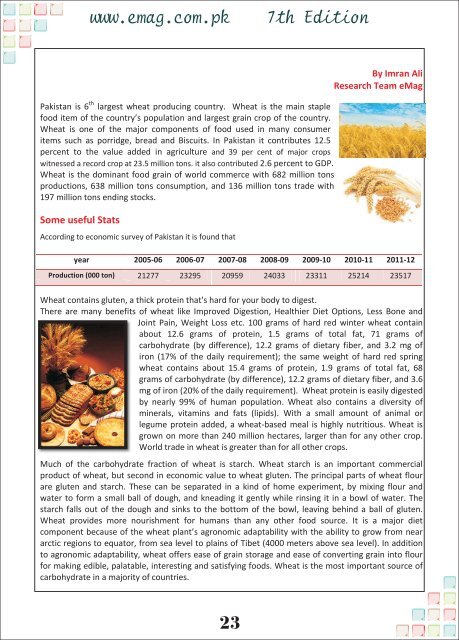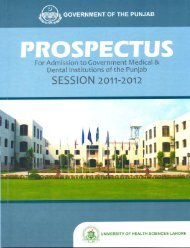Create successful ePaper yourself
Turn your PDF publications into a flip-book with our unique Google optimized e-Paper software.
www.emag.<strong>com</strong>.<strong>pk</strong><br />
7th Edition<br />
Pakistan is 6 th largest wheat producing country. Wheat is the main staple<br />
food item of the country’s population and largest grain crop of the country.<br />
Wheat is one of the major <strong>com</strong>ponents of food used in many consumer<br />
items such as porridge, bread and Biscuits. In Pakistan it contributes 12.5<br />
percent to the value added in agriculture and 39 per cent of major crops<br />
witnessed a record crop at 23.5 million tons. it also contributed 2.6 percent to GDP.<br />
Wheat is the dominant food grain of world <strong>com</strong>merce with 682 million tons<br />
productions, 638 million tons consumption, and 136 million tons trade with<br />
197 million tons ending stocks.<br />
Some useful Stats<br />
According to economic survey of Pakistan it is found that<br />
By Imran Ali<br />
Research Team eMag<br />
year 2005-06 2006-07 2007-08 2008-09 2009-10 2010-11 2011-12<br />
Production (000 ton) 21277 23295 20959 24033 23311 25214 23517<br />
Wheat contains gluten, a thick protein that's hard for your body to digest.<br />
There are many benefits of wheat like Improved Digestion, Healthier Diet Options, Less Bone and<br />
Joint Pain, Weight Loss etc. 100 grams of hard red winter wheat contain<br />
about 12.6 grams of protein, 1.5 grams of total fat, 71 grams of<br />
carbohydrate (by difference), 12.2 grams of dietary fiber, and 3.2 mg of<br />
iron (17% of the daily requirement); the same weight of hard red spring<br />
wheat contains about 15.4 grams of protein, 1.9 grams of total fat, 68<br />
grams of carbohydrate (by difference), 12.2 grams of dietary fiber, and 3.6<br />
mg of iron (20% of the daily requirement). Wheat protein is easily digested<br />
by nearly 99% of human population. Wheat also contains a diversity of<br />
minerals, vitamins and fats (lipids). With a small amount of animal or<br />
legume protein added, a wheat-based meal is highly nutritious. Wheat is<br />
grown on more than 240 million hectares, larger than for any other crop.<br />
World trade in wheat is greater than for all other crops.<br />
Much of the carbohydrate fraction of wheat is starch. Wheat starch is an important <strong>com</strong>mercial<br />
product of wheat, but second in economic value to wheat gluten. The principal parts of wheat flour<br />
are gluten and starch. These can be separated in a kind of home experiment, by mixing flour and<br />
water to form a small ball of dough, and kneading it gently while rinsing it in a bowl of water. The<br />
starch falls out of the dough and sinks to the bottom of the bowl, leaving behind a ball of gluten.<br />
Wheat provides more nourishment for humans than any other food source. It is a major diet<br />
<strong>com</strong>ponent because of the wheat plant’s agronomic adaptability with the ability to grow from near<br />
arctic regions to equator, from sea level to plains of Tibet (4000 meters above sea level). In addition<br />
to agronomic adaptability, wheat offers ease of grain storage and ease of converting grain into flour<br />
for making edible, palatable, interesting and satisfying foods. Wheat is the most important source of<br />
carbohydrate in a majority of countries.<br />
23






